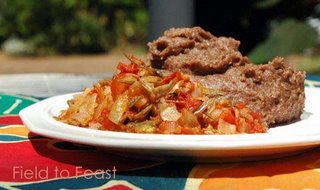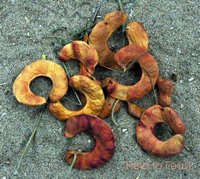 Last Saturday, Mark, Dorothy and I had a memorable visit to Mbare Musika. This Saturday, Dorothy and I began cooking with our market bounty. Today’s lunch? Sadza rauzviyo, served with kapenta relish. Before we get to these recipes, a here’s little background on sadza, kapenta and relish.
Last Saturday, Mark, Dorothy and I had a memorable visit to Mbare Musika. This Saturday, Dorothy and I began cooking with our market bounty. Today’s lunch? Sadza rauzviyo, served with kapenta relish. Before we get to these recipes, a here’s little background on sadza, kapenta and relish.
Sadza is the cornerstone of traditional Zimbabwean food, and it can be made with several different types of refined meals. Maize meal is the most popular meal used to make sadza, and it is the meal you typically find for sale in supermarkets. At Mbare market, we were able to buy both sorghum meal and rapoko (finger millet meal, also called zviyo). These meals are rarely stocked in the shops, and are more often eaten in rural areas. Sadza made from maize meal is a light cream color, sadza made from sorghum is light brown, and sadza made from rapoko is a deep, almost purple-brown. A colleague of mine told me that his young daughter calls sadza made from sorghum or rapoko “mud sadza.”
Kapenta, meanwhile, is a type of sardine, originally from Lake Tanganyika in East Africa, which has been introduced to other African lakes, including Lake Kariba. Lake Kariba is a mammoth, manmade lake in northwest Zimbabwe, along the country’s border with Zambia. It was formed in the late 1950s through construction of a dam which provides hydroelectric power to the two countries. In the late 1960s, hundreds of thousands of kapenta were air-lifted from Lake Tanganyika to Lake Kariba. Kapenta fishing is now an important industry. Kapenta are attracted to lights, so the fish are caught at night, sun-dried the next day and distributed throughout the country.
As for relish, well, in Zimbabwe, a relish is the term for just about everything on a person’s plate other than sadza. Sadza is the focus on the meal, and all other components – meat, chicken, greens, kapenta: that’s relish. So, for the moment, forget about the sweet green stuff you dot (or slather) on a hot dog and think small, smelly fish.
Kapenta Relish
Serves 2-3
½ cup dried kapenta
1 teaspoon vegetable oil
1 small onion, chopped
2 small tomatoes, chopped
Pinch of salt
Soak the kapenta in warm water for about 10 minutes. They will, in a very unsettling way, look as if they are returning to life. In order to avoid staring at the rejuvenating kapenta, begin heating the oil in a small frypan over medium-high heat. When the oil is hot, add the onion and sauté for five minutes, or until the onion is translucent. Then, add the tomatoes and the salt. Continue frying, stirring occasionally, for another 5 minutes, or until all the liquid from the tomatoes has been absorbed. Drain the kapenta, and add them to the frypan. Cook for another 5 minutes, and serve with sadza.
Sadza Rauzviyo
Serves 2-3
2 cups water
2 cups zviyo (a.k.a. rapoko)
 Bring the water to a boil in a medium saucepan. Turn heat down to medium-high and sprinkle ¾ cup of the meal (a big wooden-spoonful) over the top of the boiling water. Stir briskly, pressing the wooden spoon against the side of the pot to remove any lumps. Keep stirring for about five minutes.
Bring the water to a boil in a medium saucepan. Turn heat down to medium-high and sprinkle ¾ cup of the meal (a big wooden-spoonful) over the top of the boiling water. Stir briskly, pressing the wooden spoon against the side of the pot to remove any lumps. Keep stirring for about five minutes.
 When the mixture is smooth and is beginning to puff and bubble like lava (or, to my eye, the hot mud pools in Rotorua), stop stirring and keep a safe distance from the pot so you will not get hit by a lava burst. After 10 minutes, add another ½ cup of the meal and stir, stir, stir. Once it has been absorbed, add another ½ cup of meal. Stir, stir, stir. Add the remaining ¼ cup, and stir again. The sadza should be thick and smooth, and your arm will be tired. Spoon the sadza onto a plate and let it cool for a few minutes.
When the mixture is smooth and is beginning to puff and bubble like lava (or, to my eye, the hot mud pools in Rotorua), stop stirring and keep a safe distance from the pot so you will not get hit by a lava burst. After 10 minutes, add another ½ cup of the meal and stir, stir, stir. Once it has been absorbed, add another ½ cup of meal. Stir, stir, stir. Add the remaining ¼ cup, and stir again. The sadza should be thick and smooth, and your arm will be tired. Spoon the sadza onto a plate and let it cool for a few minutes.
Sadza is traditionally eaten with your right hand. Collect some sadza in your right hand, and use it to scoop up your relish – in this case, the kapenta relish. I like sadza rauzviyo much better than the more popular maize-meal sadza; it has a rich, earthy, slightly nutty taste that is very comforting. The kapenta relish is a little too fishy tasting (and smelling) for me, but if you like anchovies and sardines, you will enjoy this relish.
Muddy sadza, smelly fish, tasty lunch.

Tags:
recipe, sadza, Zimbabwe, rapoko, rauzviyo, kapenta, relish, main meal, Field to Feast, food blog, Africa
 Last December I spent 10 days eating (and working) in
Last December I spent 10 days eating (and working) in 












